Unit 2 It's Show Time Lesson 12 A Blog about the Silk Road 教学设计
文档属性
| 名称 | Unit 2 It's Show Time Lesson 12 A Blog about the Silk Road 教学设计 | 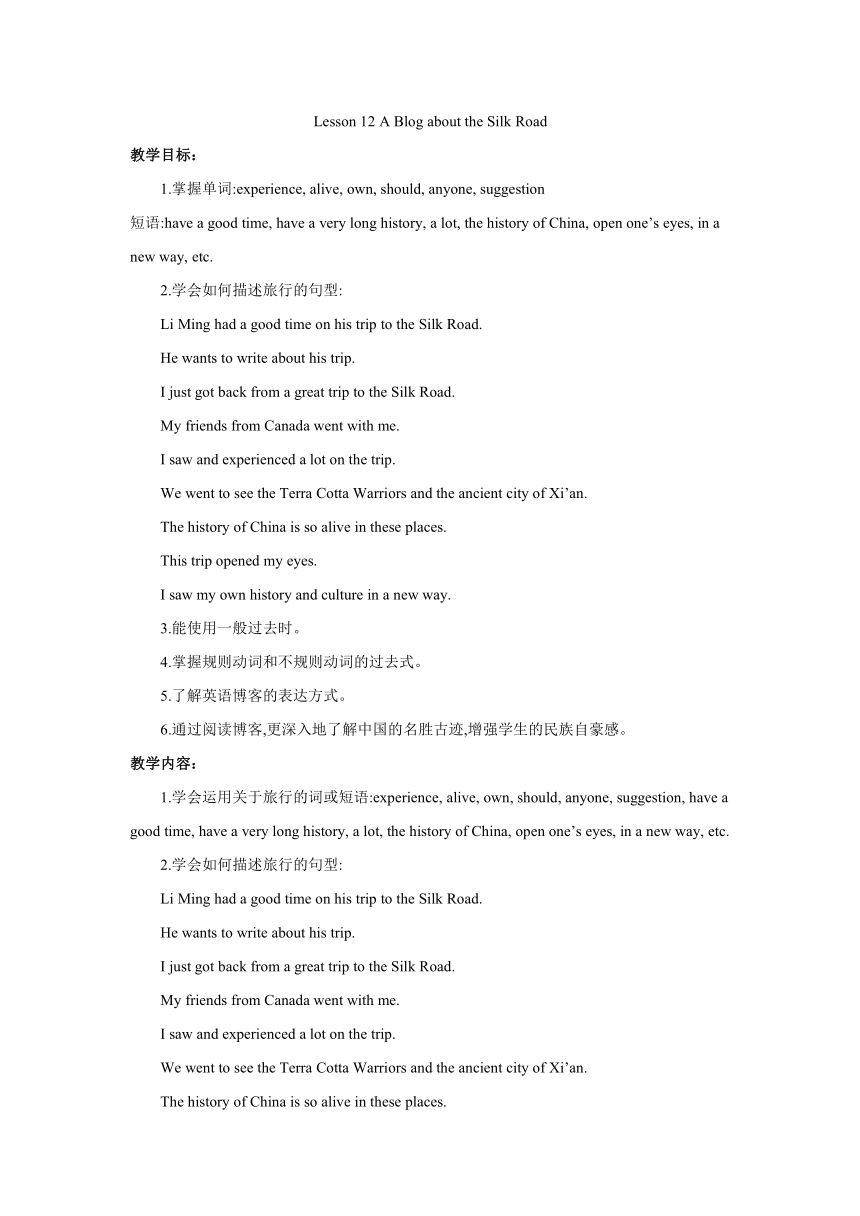 | |
| 格式 | zip | ||
| 文件大小 | 31.5KB | ||
| 资源类型 | 教案 | ||
| 版本资源 | 冀教版 | ||
| 科目 | 英语 | ||
| 更新时间 | 2019-06-27 06:44:39 | ||
图片预览

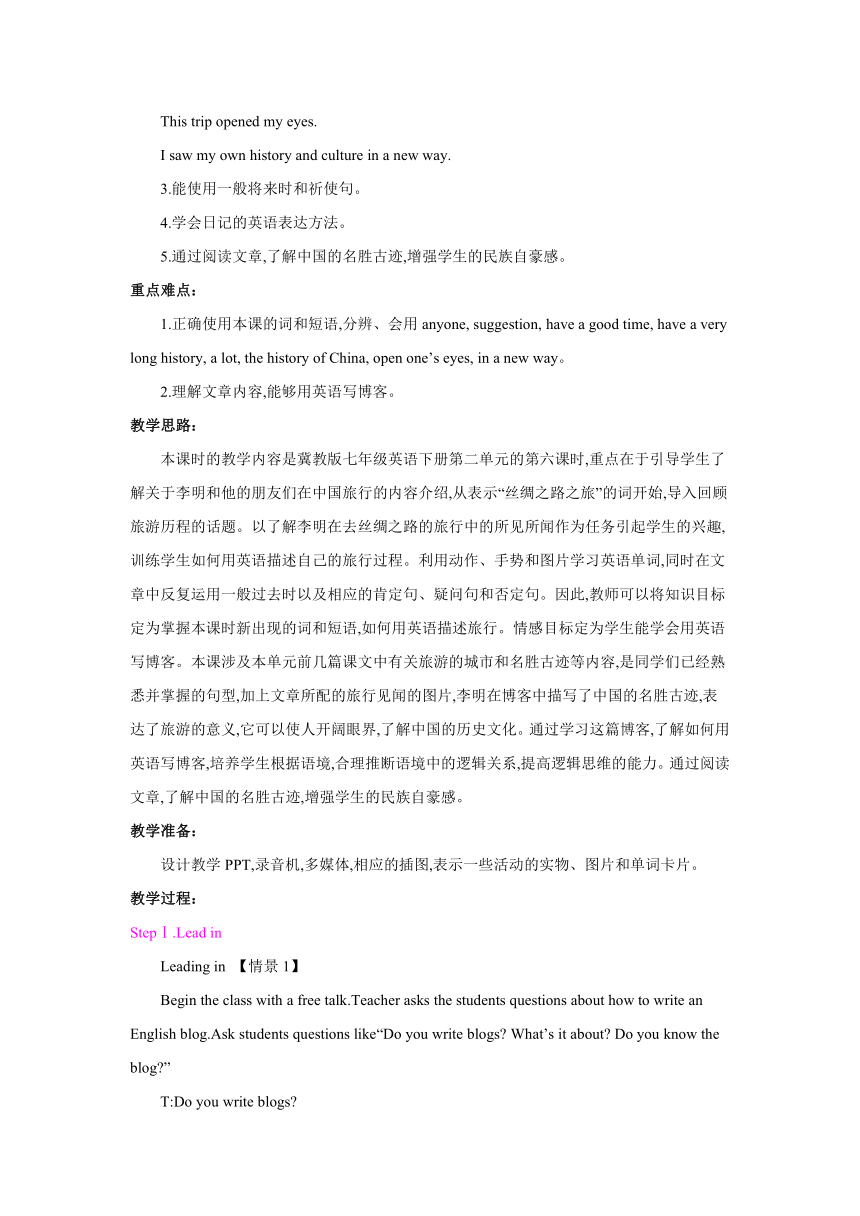
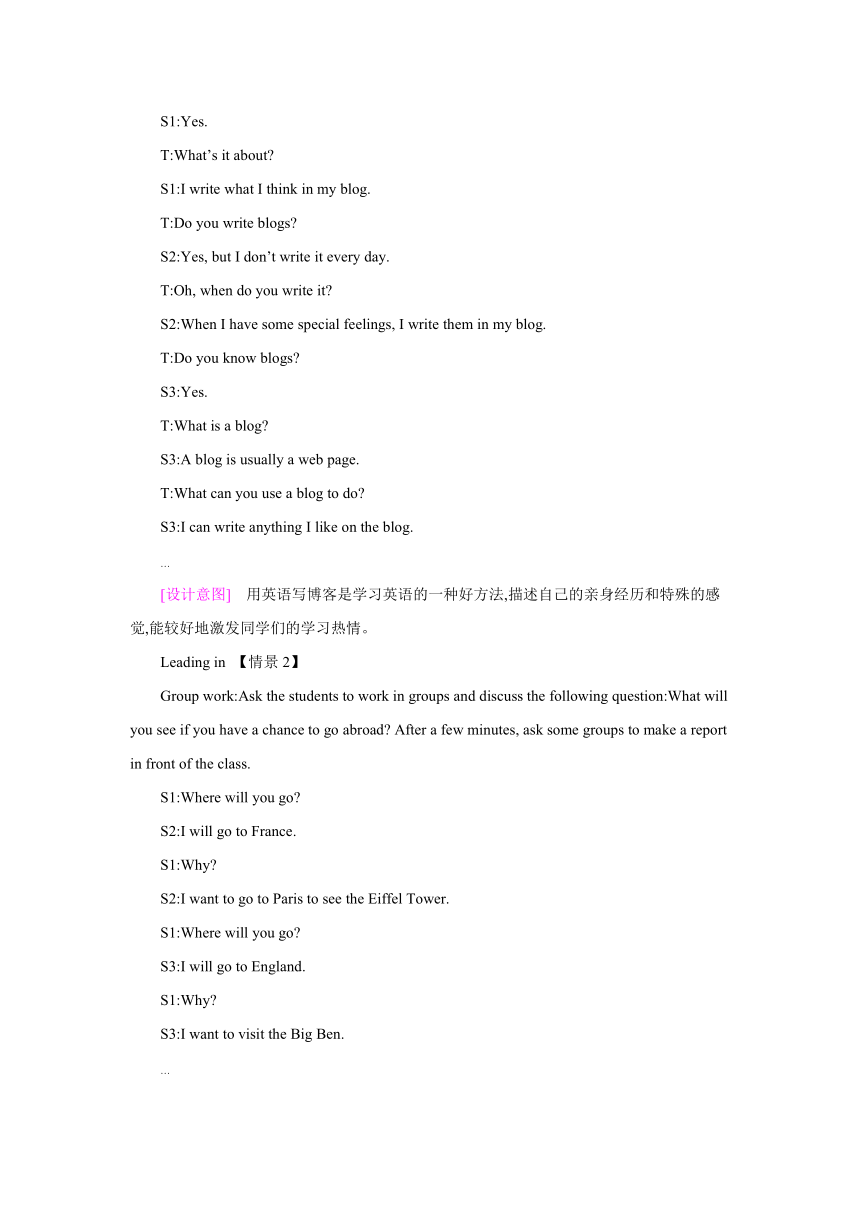
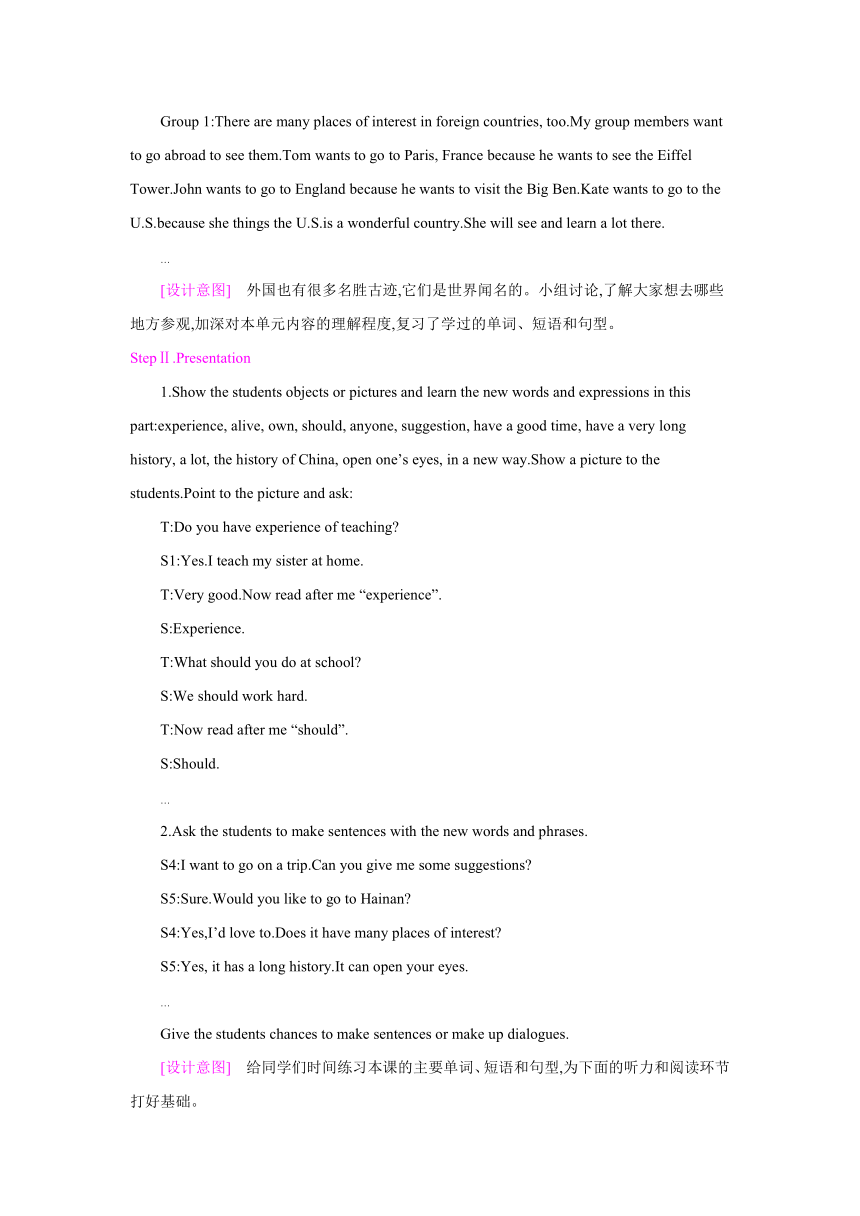
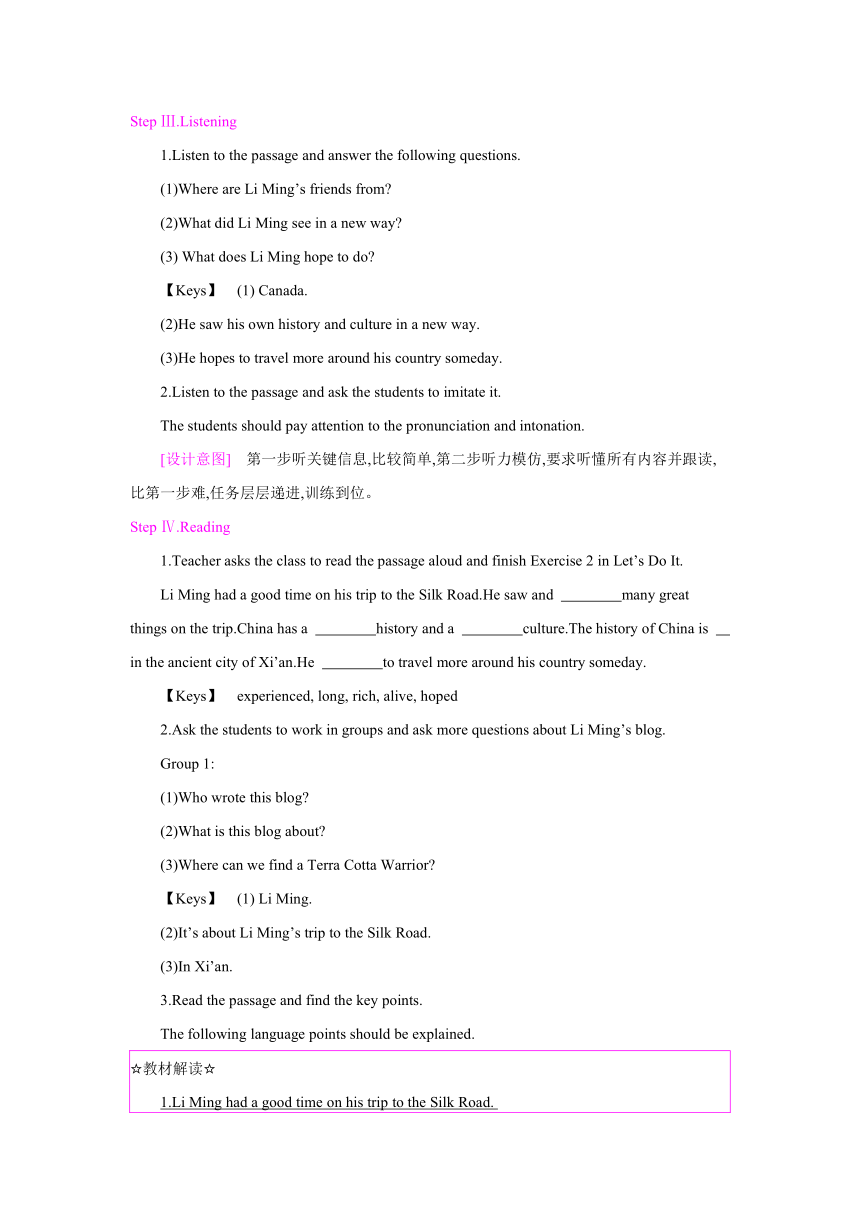
文档简介
Lesson 12 A Blog about the Silk Road
教学目标:
1.掌握单词:experience, alive, own, should, anyone, suggestion
短语:have a good time, have a very long history, a lot, the history of China, open one’s eyes, in a new way, etc.
2.学会如何描述旅行的句型:
Li Ming had a good time on his trip to the Silk Road.
He wants to write about his trip.
I just got back from a great trip to the Silk Road.
My friends from Canada went with me.
I saw and experienced a lot on the trip.
We went to see the Terra Cotta Warriors and the ancient city of Xi’an.
The history of China is so alive in these places.
This trip opened my eyes.
I saw my own history and culture in a new way.
3.能使用一般过去时。
4.掌握规则动词和不规则动词的过去式。
5.了解英语博客的表达方式。
6.通过阅读博客,更深入地了解中国的名胜古迹,增强学生的民族自豪感。
教学内容:
1.学会运用关于旅行的词或短语:experience, alive, own, should, anyone, suggestion, have a good time, have a very long history, a lot, the history of China, open one’s eyes, in a new way, etc.
2.学会如何描述旅行的句型:
Li Ming had a good time on his trip to the Silk Road.
He wants to write about his trip.
I just got back from a great trip to the Silk Road.
My friends from Canada went with me.
I saw and experienced a lot on the trip.
We went to see the Terra Cotta Warriors and the ancient city of Xi’an.
The history of China is so alive in these places.
This trip opened my eyes.
I saw my own history and culture in a new way.
3.能使用一般将来时和祈使句。
4.学会日记的英语表达方法。
5.通过阅读文章,了解中国的名胜古迹,增强学生的民族自豪感。
重点难点:
1.正确使用本课的词和短语,分辨、会用anyone, suggestion, have a good time, have a very long history, a lot, the history of China, open one’s eyes, in a new way。
2.理解文章内容,能够用英语写博客。
教学思路:
本课时的教学内容是冀教版七年级英语下册第二单元的第六课时,重点在于引导学生了解关于李明和他的朋友们在中国旅行的内容介绍,从表示“丝绸之路之旅”的词开始,导入回顾旅游历程的话题。以了解李明在去丝绸之路的旅行中的所见所闻作为任务引起学生的兴趣,训练学生如何用英语描述自己的旅行过程。利用动作、手势和图片学习英语单词,同时在文章中反复运用一般过去时以及相应的肯定句、疑问句和否定句。因此,教师可以将知识目标定为掌握本课时新出现的词和短语,如何用英语描述旅行。情感目标定为学生能学会用英语写博客。本课涉及本单元前几篇课文中有关旅游的城市和名胜古迹等内容,是同学们已经熟悉并掌握的句型,加上文章所配的旅行见闻的图片,李明在博客中描写了中国的名胜古迹,表达了旅游的意义,它可以使人开阔眼界,了解中国的历史文化。通过学习这篇博客,了解如何用英语写博客,培养学生根据语境,合理推断语境中的逻辑关系,提高逻辑思维的能力。通过阅读文章,了解中国的名胜古迹,增强学生的民族自豪感。
教学准备:
设计教学PPT,录音机,多媒体,相应的插图,表示一些活动的实物、图片和单词卡片。
教学过程:
StepⅠ.Lead in
Leading in 【情景1】
Begin the class with a free talk.Teacher asks the students questions about how to write an English blog.Ask students questions like“Do you write blogs? What’s it about? Do you know the blog?”
T:Do you write blogs?
S1:Yes.
T:What’s it about?
S1:I write what I think in my blog.
T:Do you write blogs?
S2:Yes, but I don’t write it every day.
T:Oh, when do you write it?
S2:When I have some special feelings, I write them in my blog.
T:Do you know blogs?
S3:Yes.
T:What is a blog?
S3:A blog is usually a web page.
T:What can you use a blog to do?
S3:I can write anything I like on the blog.
…
[设计意图] 用英语写博客是学习英语的一种好方法,描述自己的亲身经历和特殊的感觉,能较好地激发同学们的学习热情。
Leading in 【情景2】
Group work:Ask the students to work in groups and discuss the following question:What will you see if you have a chance to go abroad? After a few minutes, ask some groups to make a report in front of the class.
S1:Where will you go?
S2:I will go to France.
S1:Why?
S2:I want to go to Paris to see the Eiffel Tower.
S1:Where will you go?
S3:I will go to England.
S1:Why?
S3:I want to visit the Big Ben.
…
Group 1:There are many places of interest in foreign countries, too.My group members want to go abroad to see them.Tom wants to go to Paris, France because he wants to see the Eiffel Tower.John wants to go to England because he wants to visit the Big Ben.Kate wants to go to the U.S.because she things the U.S.is a wonderful country.She will see and learn a lot there.
…
[设计意图] 外国也有很多名胜古迹,它们是世界闻名的。小组讨论,了解大家想去哪些地方参观,加深对本单元内容的理解程度,复习了学过的单词、短语和句型。
StepⅡ.Presentation
1.Show the students objects or pictures and learn the new words and expressions in this part:experience, alive, own, should, anyone, suggestion, have a good time, have a very long history, a lot, the history of China, open one’s eyes, in a new way.Show a picture to the students.Point to the picture and ask:
T:Do you have experience of teaching?
S1:Yes.I teach my sister at home.
T:Very good.Now read after me “experience”.
S:Experience.
T:What should you do at school?
S:We should work hard.
T:Now read after me “should”.
S:Should.
…
2.Ask the students to make sentences with the new words and phrases.
S4:I want to go on a trip.Can you give me some suggestions?
S5:Sure.Would you like to go to Hainan?
S4:Yes,I’d love to.Does it have many places of interest?
S5:Yes, it has a long history.It can open your eyes.
…
Give the students chances to make sentences or make up dialogues.
[设计意图] 给同学们时间练习本课的主要单词、短语和句型,为下面的听力和阅读环节打好基础。
Step Ⅲ.Listening
1.Listen to the passage and answer the following questions.
(1)Where are Li Ming’s friends from?
(2)What did Li Ming see in a new way?
(3) What does Li Ming hope to do?
【Keys】 (1) Canada.
(2)He saw his own history and culture in a new way.
(3)He hopes to travel more around his country someday.
2.Listen to the passage and ask the students to imitate it.
The students should pay attention to the pronunciation and intonation.
[设计意图] 第一步听关键信息,比较简单,第二步听力模仿,要求听懂所有内容并跟读,比第一步难,任务层层递进,训练到位。
Step Ⅳ.Reading
1.Teacher asks the class to read the passage aloud and finish Exercise 2 in Let’s Do It.
Li Ming had a good time on his trip to the Silk Road.He saw and many great things on the trip.China has a history and a culture.The history of China is in the ancient city of Xi’an.He to travel more around his country someday.?
【Keys】 experienced, long, rich, alive, hoped
2.Ask the students to work in groups and ask more questions about Li Ming’s blog.
Group 1:
(1)Who wrote this blog?
(2)What is this blog about?
(3)Where can we find a Terra Cotta Warrior?
【Keys】 (1) Li Ming.
(2)It’s about Li Ming’s trip to the Silk Road.
(3)In Xi’an.
3.Read the passage and find the key points.
The following language points should be explained.
☆教材解读☆
1.Li Ming had a good time on his trip to the Silk Road.?
have a good time = have fun/enjoy oneself意为“玩得高兴”。good 也可用nice, wonderful, pleasant 代替。have是实义动词。
Did you have fun last night?
昨晚你玩得高兴吗?
2.I just got back from a great trip to the Silk Road.?
get back from意为“从……回来”。get back to…= return to…意为“回到……”。get back home 意为“回到家”。
He will get back to Beijing this summer.
今年夏天他将回到北京。
3.I saw and experienced a lot on the trip.?
◆experience用作动词,表示“体验,经历”。
He experienced a lot when he was young.
当他小的时候,他经历了很多。
【拓展】 (1)experience用作名词,表示“经验,体验”,是不可数名词。
He has much experience in the work.
他做这个工作很有经验。
(2)experience表示“经历”,通常是可数名词。
He had many interesting experiences while travelling in Africa.他在非洲旅行时,有很多有趣的经历。
◆句中的a lot用在动词saw 和 experienced 后作状语,意为“ 很多”。
We learned a lot on the farm.What about you?我们在农场上学到很多。你呢?
4.The history of China is so alive in these places.?
alive用作形容词,意为“活跃的;生动的”,为表语形容词,常用来指人,有时也可指物,作表语时与living 互换,作定语时,为后置定语。
He is very alive.他非常活跃。
5.I saw my own history and culture in a new way.?
◆own在句中用作形容词,意为“自己的”。
You should see it with your own eyes.
你应该用你自己的眼睛看。
【拓展】 (1)own为代词时,意为“自己的东西,属于自己的东西”,其后不接名词。无论是作形容词还是代词,其前都必须有名词所有格,或形容词性物主代词。
This car is my own.这辆汽车是我自己的。
(2)own为动词时,意为“所有,拥有”,等于have。
I want to own a big house.
我想拥有一个大房子。
◆in a new way意为“以一种新的方式”。
I can think about it in a new way.
我可以以一种新的方式来思考它。
6.Where should I go next??
should应该,将要,后跟动词原形,否定结构是“shouldn’t”,即“不应该”。
What should I do?我应该做什么?
You shouldn’t eat in the classroom.
你不应该在教室里吃东西。
7.Does anyone have any suggestions??
◆【辨析】 anyone,any one
(1)anyone=anybody,表示任何人,其后不可接of短语,用作主语时,谓语动词用单数。
Is anyone waiting for you?有人在等你吗?
(2)any one任何一个(人或物),用来表示只限一个,通常与of 短语连用。
You can have any one of the cars.
你可以要车里面的任意一辆。
◆suggestion 用作名词,意为“建议”,属于可数名词。
Could you give me some suggestions on how to learn English?你能给我一些如何学英语的建议吗?
[设计意图] 读文章,找出问题的答案或补充文章,设计这样的阅读题有助于学生理解文章细节。
Step Ⅴ.Practice Writing
1.Ask the students to retell the blog.
2.Ask the students to write a blog about one of their favourite trips.Every group chooses the best to read in front of the class.
When the students are writing, the teacher should walk around and give them advice.
[设计意图] 让学生们复述课文,然后写关于“你最喜欢的一次旅行”的博客,描述其中最精彩的环节,这是写作练习,是今天的主题的升华。
Step Ⅵ.Complete Let’s Do It!
Exercise 1 is used to practice the students’ listening.Listen to the tape and finish Exercise 1.Teacher checks the answers in class.We have finished Exercise 2 in reading part of the class.Ask the students to finish Exercise 3 by themselves in class.Teacher checks their answers in class.
[设计意图] Let’s Do It!部分中的Exercise 1重点是听说教学,考查同学们对课文的关键信息是否听清。Exercise 2重点是词汇教学,在课上作为阅读任务让同学们做。Exercise 3考查同学们对课文的掌握程度。
Step Ⅶ.Task
Group work:Let’s Do It! Exercise 4.
Write an e-mail to a friend about a trip you went on.Show him or her some pictures from your trip.
Task tips:Where/When did you go?Who did you go with? What did you see and experience? Did you eat any traditional or special foods?
[设计意图] 小组合作,给朋友写一封关于你的旅行的电子邮件,给他、她看一些旅游的照片,介绍这些地方的有特色的建筑物和美食。主要目的是练习本单元的主要语法内容:一般过去时,规则动词和不规则动词的过去式,同时练习本课的主要单词、短语和句型。
Step Ⅷ.Exercises
Fill in the blanks.
1.在旅途中我看到了很多,也经历了很多。
I saw and on the trip.?
2.在这些地方中国的历史如此生动。
The history of China is in these places.?
3.我用一种新的方法看到了我自己的历史和文化。
I my own history and culture .?
4.接下来我该去哪?
Where I next? ?
5.有没有人给些建议呢?
Does have any ? ?
【Keys】 1.experienced a lot 2.so alive 3.saw, in a new way 4.should,go 5.anyone, suggestions
[设计意图] 以学评教、强化落实。当堂检测主要是由本节内容组成的形成性评价,让学生们巩固本课所学内容。
Step Ⅸ.Homework
1.Learn the new words and expressions by heart.
2.Read the blog after class.
3.Go over what you’ve learnt in this unit.
[设计意图] 听、说、读、写相结合,全方位训练学生各方面的英语能力。
Lesson 12 A Blog about the Silk Road
experience, alive, own, should,
anyone, suggestion, have a good time,
have a very long history, a lot,
the history of China, open one’s eyes, in a new way
He wants to write about his trip.
I saw and experienced a lot on the trip.
This trip opened my eyes.
My friends from Canada went with me.
I just got back from a great trip to the Silk Road.
The history of China is so alive in these places.
I saw my own history and culture in a new way.
Li Ming had a good time on his trip to the Silk Road.
We went to see the Terra Cotta Warriors and the ancient city of Xi’an.
教材习题解答
【Keys】
2 第2幅图, 第3幅图
语法精讲
一般过去时
(一) 定义
一般过去时表示过去经常进行的动作或所处的状态,多与时间状语yesterday, last…,…ago, just now, the other day, once upon a time, when she was young等连用。
(二)句式结构
肯定句式: 主语+过去式.
否定句式: 主语+助动词didn’t+动词原形.
疑问句式: 助动词Did+主语+动词原形?
(三)一般过去时的用法
1.表示过去某一时刻或某段时间发生的事,多与时间点或时间段连用。
I studied in this school ten years ago.
十年前我在这所学校学习。
I got up at six this morning.
今天早晨我六点起床的。
2.表示过去连续发生的动作,往往没有时间状语,而是通过上下文来表明过去的含义。
She opened the window, looked out and found some birds in the sky.她 打开窗户、向外看了看, 看到空中有一些鸟。
3.某些句子,虽然没有表示过去确定时间的状语,但实际上是指过去发生的动作或存在的状态,也应该使用过去时。
I didn’t know you were here.
我不知道你在这里。
We thought you were ill.
我们以为你病了 。
(四)动词过去式的变化
动词的过去式有规则变化和不规则变化两种形式,一般是在词尾加-ed构成。不规则变化的过去式没有特定的规律,需要特别记忆。
1.规则变化的过去式
(1)一般情况下,在动词的词尾加ed构成。
walk—walked, offer—offered, join—joined
(2)以不发音字母e结尾的,直接加d构成。
live—lived, hate—hated, escape— escaped
(3)以重读闭音节结尾,并且词尾只有一个辅音字母的,要先双写这一字母再加ed。
stop —stopped,prefer—preferred
(4)以“元音字母+ y”结尾的直接加ed,以“辅音字母 + y”结尾的应先将y改为i再加ed构成。
play—played, copy—copied,try—tried,carry—carried
2.不规则变化的过去式
(1)原形和过去式相同。
花费cost cost
切割 cut cut
(2)字母o改为a。
成为 become became
来 come came
(3)过去式为ought结尾的。
带来 bring brought
买 buy bought
战斗 fight fought
想 think thought
(4)过去式为aught结尾的。
抓住catch caught
教 teach taught
(5)将eep改为ept。
保持 keep kept
打扫 sweep swept
(6)字母i改为a。
下沉 sink sank
游泳 swim swam
(7)字母ow改为ew。
知道 know knew
投掷 throw threw
教学目标:
1.掌握单词:experience, alive, own, should, anyone, suggestion
短语:have a good time, have a very long history, a lot, the history of China, open one’s eyes, in a new way, etc.
2.学会如何描述旅行的句型:
Li Ming had a good time on his trip to the Silk Road.
He wants to write about his trip.
I just got back from a great trip to the Silk Road.
My friends from Canada went with me.
I saw and experienced a lot on the trip.
We went to see the Terra Cotta Warriors and the ancient city of Xi’an.
The history of China is so alive in these places.
This trip opened my eyes.
I saw my own history and culture in a new way.
3.能使用一般过去时。
4.掌握规则动词和不规则动词的过去式。
5.了解英语博客的表达方式。
6.通过阅读博客,更深入地了解中国的名胜古迹,增强学生的民族自豪感。
教学内容:
1.学会运用关于旅行的词或短语:experience, alive, own, should, anyone, suggestion, have a good time, have a very long history, a lot, the history of China, open one’s eyes, in a new way, etc.
2.学会如何描述旅行的句型:
Li Ming had a good time on his trip to the Silk Road.
He wants to write about his trip.
I just got back from a great trip to the Silk Road.
My friends from Canada went with me.
I saw and experienced a lot on the trip.
We went to see the Terra Cotta Warriors and the ancient city of Xi’an.
The history of China is so alive in these places.
This trip opened my eyes.
I saw my own history and culture in a new way.
3.能使用一般将来时和祈使句。
4.学会日记的英语表达方法。
5.通过阅读文章,了解中国的名胜古迹,增强学生的民族自豪感。
重点难点:
1.正确使用本课的词和短语,分辨、会用anyone, suggestion, have a good time, have a very long history, a lot, the history of China, open one’s eyes, in a new way。
2.理解文章内容,能够用英语写博客。
教学思路:
本课时的教学内容是冀教版七年级英语下册第二单元的第六课时,重点在于引导学生了解关于李明和他的朋友们在中国旅行的内容介绍,从表示“丝绸之路之旅”的词开始,导入回顾旅游历程的话题。以了解李明在去丝绸之路的旅行中的所见所闻作为任务引起学生的兴趣,训练学生如何用英语描述自己的旅行过程。利用动作、手势和图片学习英语单词,同时在文章中反复运用一般过去时以及相应的肯定句、疑问句和否定句。因此,教师可以将知识目标定为掌握本课时新出现的词和短语,如何用英语描述旅行。情感目标定为学生能学会用英语写博客。本课涉及本单元前几篇课文中有关旅游的城市和名胜古迹等内容,是同学们已经熟悉并掌握的句型,加上文章所配的旅行见闻的图片,李明在博客中描写了中国的名胜古迹,表达了旅游的意义,它可以使人开阔眼界,了解中国的历史文化。通过学习这篇博客,了解如何用英语写博客,培养学生根据语境,合理推断语境中的逻辑关系,提高逻辑思维的能力。通过阅读文章,了解中国的名胜古迹,增强学生的民族自豪感。
教学准备:
设计教学PPT,录音机,多媒体,相应的插图,表示一些活动的实物、图片和单词卡片。
教学过程:
StepⅠ.Lead in
Leading in 【情景1】
Begin the class with a free talk.Teacher asks the students questions about how to write an English blog.Ask students questions like“Do you write blogs? What’s it about? Do you know the blog?”
T:Do you write blogs?
S1:Yes.
T:What’s it about?
S1:I write what I think in my blog.
T:Do you write blogs?
S2:Yes, but I don’t write it every day.
T:Oh, when do you write it?
S2:When I have some special feelings, I write them in my blog.
T:Do you know blogs?
S3:Yes.
T:What is a blog?
S3:A blog is usually a web page.
T:What can you use a blog to do?
S3:I can write anything I like on the blog.
…
[设计意图] 用英语写博客是学习英语的一种好方法,描述自己的亲身经历和特殊的感觉,能较好地激发同学们的学习热情。
Leading in 【情景2】
Group work:Ask the students to work in groups and discuss the following question:What will you see if you have a chance to go abroad? After a few minutes, ask some groups to make a report in front of the class.
S1:Where will you go?
S2:I will go to France.
S1:Why?
S2:I want to go to Paris to see the Eiffel Tower.
S1:Where will you go?
S3:I will go to England.
S1:Why?
S3:I want to visit the Big Ben.
…
Group 1:There are many places of interest in foreign countries, too.My group members want to go abroad to see them.Tom wants to go to Paris, France because he wants to see the Eiffel Tower.John wants to go to England because he wants to visit the Big Ben.Kate wants to go to the U.S.because she things the U.S.is a wonderful country.She will see and learn a lot there.
…
[设计意图] 外国也有很多名胜古迹,它们是世界闻名的。小组讨论,了解大家想去哪些地方参观,加深对本单元内容的理解程度,复习了学过的单词、短语和句型。
StepⅡ.Presentation
1.Show the students objects or pictures and learn the new words and expressions in this part:experience, alive, own, should, anyone, suggestion, have a good time, have a very long history, a lot, the history of China, open one’s eyes, in a new way.Show a picture to the students.Point to the picture and ask:
T:Do you have experience of teaching?
S1:Yes.I teach my sister at home.
T:Very good.Now read after me “experience”.
S:Experience.
T:What should you do at school?
S:We should work hard.
T:Now read after me “should”.
S:Should.
…
2.Ask the students to make sentences with the new words and phrases.
S4:I want to go on a trip.Can you give me some suggestions?
S5:Sure.Would you like to go to Hainan?
S4:Yes,I’d love to.Does it have many places of interest?
S5:Yes, it has a long history.It can open your eyes.
…
Give the students chances to make sentences or make up dialogues.
[设计意图] 给同学们时间练习本课的主要单词、短语和句型,为下面的听力和阅读环节打好基础。
Step Ⅲ.Listening
1.Listen to the passage and answer the following questions.
(1)Where are Li Ming’s friends from?
(2)What did Li Ming see in a new way?
(3) What does Li Ming hope to do?
【Keys】 (1) Canada.
(2)He saw his own history and culture in a new way.
(3)He hopes to travel more around his country someday.
2.Listen to the passage and ask the students to imitate it.
The students should pay attention to the pronunciation and intonation.
[设计意图] 第一步听关键信息,比较简单,第二步听力模仿,要求听懂所有内容并跟读,比第一步难,任务层层递进,训练到位。
Step Ⅳ.Reading
1.Teacher asks the class to read the passage aloud and finish Exercise 2 in Let’s Do It.
Li Ming had a good time on his trip to the Silk Road.He saw and many great things on the trip.China has a history and a culture.The history of China is in the ancient city of Xi’an.He to travel more around his country someday.?
【Keys】 experienced, long, rich, alive, hoped
2.Ask the students to work in groups and ask more questions about Li Ming’s blog.
Group 1:
(1)Who wrote this blog?
(2)What is this blog about?
(3)Where can we find a Terra Cotta Warrior?
【Keys】 (1) Li Ming.
(2)It’s about Li Ming’s trip to the Silk Road.
(3)In Xi’an.
3.Read the passage and find the key points.
The following language points should be explained.
☆教材解读☆
1.Li Ming had a good time on his trip to the Silk Road.?
have a good time = have fun/enjoy oneself意为“玩得高兴”。good 也可用nice, wonderful, pleasant 代替。have是实义动词。
Did you have fun last night?
昨晚你玩得高兴吗?
2.I just got back from a great trip to the Silk Road.?
get back from意为“从……回来”。get back to…= return to…意为“回到……”。get back home 意为“回到家”。
He will get back to Beijing this summer.
今年夏天他将回到北京。
3.I saw and experienced a lot on the trip.?
◆experience用作动词,表示“体验,经历”。
He experienced a lot when he was young.
当他小的时候,他经历了很多。
【拓展】 (1)experience用作名词,表示“经验,体验”,是不可数名词。
He has much experience in the work.
他做这个工作很有经验。
(2)experience表示“经历”,通常是可数名词。
He had many interesting experiences while travelling in Africa.他在非洲旅行时,有很多有趣的经历。
◆句中的a lot用在动词saw 和 experienced 后作状语,意为“ 很多”。
We learned a lot on the farm.What about you?我们在农场上学到很多。你呢?
4.The history of China is so alive in these places.?
alive用作形容词,意为“活跃的;生动的”,为表语形容词,常用来指人,有时也可指物,作表语时与living 互换,作定语时,为后置定语。
He is very alive.他非常活跃。
5.I saw my own history and culture in a new way.?
◆own在句中用作形容词,意为“自己的”。
You should see it with your own eyes.
你应该用你自己的眼睛看。
【拓展】 (1)own为代词时,意为“自己的东西,属于自己的东西”,其后不接名词。无论是作形容词还是代词,其前都必须有名词所有格,或形容词性物主代词。
This car is my own.这辆汽车是我自己的。
(2)own为动词时,意为“所有,拥有”,等于have。
I want to own a big house.
我想拥有一个大房子。
◆in a new way意为“以一种新的方式”。
I can think about it in a new way.
我可以以一种新的方式来思考它。
6.Where should I go next??
should应该,将要,后跟动词原形,否定结构是“shouldn’t”,即“不应该”。
What should I do?我应该做什么?
You shouldn’t eat in the classroom.
你不应该在教室里吃东西。
7.Does anyone have any suggestions??
◆【辨析】 anyone,any one
(1)anyone=anybody,表示任何人,其后不可接of短语,用作主语时,谓语动词用单数。
Is anyone waiting for you?有人在等你吗?
(2)any one任何一个(人或物),用来表示只限一个,通常与of 短语连用。
You can have any one of the cars.
你可以要车里面的任意一辆。
◆suggestion 用作名词,意为“建议”,属于可数名词。
Could you give me some suggestions on how to learn English?你能给我一些如何学英语的建议吗?
[设计意图] 读文章,找出问题的答案或补充文章,设计这样的阅读题有助于学生理解文章细节。
Step Ⅴ.Practice Writing
1.Ask the students to retell the blog.
2.Ask the students to write a blog about one of their favourite trips.Every group chooses the best to read in front of the class.
When the students are writing, the teacher should walk around and give them advice.
[设计意图] 让学生们复述课文,然后写关于“你最喜欢的一次旅行”的博客,描述其中最精彩的环节,这是写作练习,是今天的主题的升华。
Step Ⅵ.Complete Let’s Do It!
Exercise 1 is used to practice the students’ listening.Listen to the tape and finish Exercise 1.Teacher checks the answers in class.We have finished Exercise 2 in reading part of the class.Ask the students to finish Exercise 3 by themselves in class.Teacher checks their answers in class.
[设计意图] Let’s Do It!部分中的Exercise 1重点是听说教学,考查同学们对课文的关键信息是否听清。Exercise 2重点是词汇教学,在课上作为阅读任务让同学们做。Exercise 3考查同学们对课文的掌握程度。
Step Ⅶ.Task
Group work:Let’s Do It! Exercise 4.
Write an e-mail to a friend about a trip you went on.Show him or her some pictures from your trip.
Task tips:Where/When did you go?Who did you go with? What did you see and experience? Did you eat any traditional or special foods?
[设计意图] 小组合作,给朋友写一封关于你的旅行的电子邮件,给他、她看一些旅游的照片,介绍这些地方的有特色的建筑物和美食。主要目的是练习本单元的主要语法内容:一般过去时,规则动词和不规则动词的过去式,同时练习本课的主要单词、短语和句型。
Step Ⅷ.Exercises
Fill in the blanks.
1.在旅途中我看到了很多,也经历了很多。
I saw and on the trip.?
2.在这些地方中国的历史如此生动。
The history of China is in these places.?
3.我用一种新的方法看到了我自己的历史和文化。
I my own history and culture .?
4.接下来我该去哪?
Where I next? ?
5.有没有人给些建议呢?
Does have any ? ?
【Keys】 1.experienced a lot 2.so alive 3.saw, in a new way 4.should,go 5.anyone, suggestions
[设计意图] 以学评教、强化落实。当堂检测主要是由本节内容组成的形成性评价,让学生们巩固本课所学内容。
Step Ⅸ.Homework
1.Learn the new words and expressions by heart.
2.Read the blog after class.
3.Go over what you’ve learnt in this unit.
[设计意图] 听、说、读、写相结合,全方位训练学生各方面的英语能力。
Lesson 12 A Blog about the Silk Road
experience, alive, own, should,
anyone, suggestion, have a good time,
have a very long history, a lot,
the history of China, open one’s eyes, in a new way
He wants to write about his trip.
I saw and experienced a lot on the trip.
This trip opened my eyes.
My friends from Canada went with me.
I just got back from a great trip to the Silk Road.
The history of China is so alive in these places.
I saw my own history and culture in a new way.
Li Ming had a good time on his trip to the Silk Road.
We went to see the Terra Cotta Warriors and the ancient city of Xi’an.
教材习题解答
【Keys】
2 第2幅图, 第3幅图
语法精讲
一般过去时
(一) 定义
一般过去时表示过去经常进行的动作或所处的状态,多与时间状语yesterday, last…,…ago, just now, the other day, once upon a time, when she was young等连用。
(二)句式结构
肯定句式: 主语+过去式.
否定句式: 主语+助动词didn’t+动词原形.
疑问句式: 助动词Did+主语+动词原形?
(三)一般过去时的用法
1.表示过去某一时刻或某段时间发生的事,多与时间点或时间段连用。
I studied in this school ten years ago.
十年前我在这所学校学习。
I got up at six this morning.
今天早晨我六点起床的。
2.表示过去连续发生的动作,往往没有时间状语,而是通过上下文来表明过去的含义。
She opened the window, looked out and found some birds in the sky.她 打开窗户、向外看了看, 看到空中有一些鸟。
3.某些句子,虽然没有表示过去确定时间的状语,但实际上是指过去发生的动作或存在的状态,也应该使用过去时。
I didn’t know you were here.
我不知道你在这里。
We thought you were ill.
我们以为你病了 。
(四)动词过去式的变化
动词的过去式有规则变化和不规则变化两种形式,一般是在词尾加-ed构成。不规则变化的过去式没有特定的规律,需要特别记忆。
1.规则变化的过去式
(1)一般情况下,在动词的词尾加ed构成。
walk—walked, offer—offered, join—joined
(2)以不发音字母e结尾的,直接加d构成。
live—lived, hate—hated, escape— escaped
(3)以重读闭音节结尾,并且词尾只有一个辅音字母的,要先双写这一字母再加ed。
stop —stopped,prefer—preferred
(4)以“元音字母+ y”结尾的直接加ed,以“辅音字母 + y”结尾的应先将y改为i再加ed构成。
play—played, copy—copied,try—tried,carry—carried
2.不规则变化的过去式
(1)原形和过去式相同。
花费cost cost
切割 cut cut
(2)字母o改为a。
成为 become became
来 come came
(3)过去式为ought结尾的。
带来 bring brought
买 buy bought
战斗 fight fought
想 think thought
(4)过去式为aught结尾的。
抓住catch caught
教 teach taught
(5)将eep改为ept。
保持 keep kept
打扫 sweep swept
(6)字母i改为a。
下沉 sink sank
游泳 swim swam
(7)字母ow改为ew。
知道 know knew
投掷 throw threw
同课章节目录
- Unit 1 A Trip to the Silk Road
- Lesson 1 A Trip to China
- Lesson 2 Meet You in Beijing
- Lesson 3 A Visit to Xi'an
- Lesson 4 A Visit to Lanzhou
- Lesson 5 Another Stop along the Silk Road
- Lesson 6 Jenny's Diary
- Unit 2 It's Show Time!
- Lesson 7 What's Your Project about?
- Lesson 8 Marco Polo and the Silk Road
- Lesson 9 Danny's School Project
- Lesson 10 Music and Dance
- Lesson 11 Food in China
- Lesson 12 A Blog about the Silk Road
- Unit 3 School Life
- Lesson 13 How Is School Going?
- Lesson 14 Jenny's School Life
- Lesson 15 Making a Difference
- Lesson 16 We Are with You!
- Lesson 17 School Science Fai
- Lesson 18 Teaching in China
- Unit 4 After-School Activities
- Lesson 19 A Dinner Date
- Lesson 20 Join Our Club!
- Lesson 21 What Is Your Club Type?
- Lesson 22 Big Plans for the Weekend
- Lesson 23 A Weekend with Grandma
- Lesson 24 How was Your Weekend?
- Unit 5 I Love Learning English!
- Lesson 25 A Phone Friend
- Lesson 26 Online Phone Calls
- Lesson 27 Amazing English
- Lesson 28 How Do I Learn English?
- Lesson 29 A Door to the World
- Lesson 30 Writing an E-mail in English
- Unit 6 Seasons
- Lesson 31 What Strange Weather!
- Lesson 32 I Can't Wait for Winter!
- Lesson 33 Kim's Favourite Season
- Lesson 34 Steven's Report
- Lesson 35 Surfing in Sydney
- Lesson 36 Spring in China
- Unit 7 Sports and Good Health
- Lesson 37 You Are What You Eat!
- Lesson 38 Stay Healthy!
- Lesson 39 Danny's Report
- Lesson 40 Move Your Body
- Lesson 41 Were People Healthy Then?
- Lesson 42 Know Yourself
- Unit 8 Summer Holiday Is Coming!
- Lesson 43 Have a Good Summer!
- Lesson 44 Volunteering in Summe
- Lesson 45 Baseball Season
- Lesson 46 Get Ready for Summer Holiday!
- Lesson 47 Summer Plans
- Lesson 48 Li Ming's Summer Holiday
